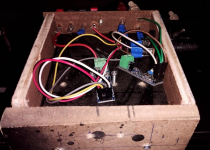Testing in stereo with prototype
More testing which was most satisfactory, dual channel. Everything works so it is time for a new enclosure to close this thing off. Needs a volume control. No soldering at all, crimped or plugged in connectors all around. The quality of the wires and connectors need to be improved, of course, not bad for first ever use of this type of crimping tool.
Uses two AC/DC adapters, apparently it is possible to use a single AC/DC converter using two resistors and two capacitors in parallel, with a centre tap.
More testing which was most satisfactory, dual channel. Everything works so it is time for a new enclosure to close this thing off. Needs a volume control. No soldering at all, crimped or plugged in connectors all around. The quality of the wires and connectors need to be improved, of course, not bad for first ever use of this type of crimping tool.
Uses two AC/DC adapters, apparently it is possible to use a single AC/DC converter using two resistors and two capacitors in parallel, with a centre tap.
Attachments
Connected the old LM386 for comparison today, it works, but many of you were right. 10 % distortion is too much at 700 mW maximum it should never reach this, however I know I cannot tolerate more than 8% distortion. I only used 4.5V so predictably, distortion was high at moderate levels of listening.
I am stuck with these things so will make the best of it, build an amplifier for practise and move on.
I am stuck with these things so will make the best of it, build an amplifier for practise and move on.
Listening tests: the amplifier sounds forward, if not bright, middle frequencies, especially guitars are very strongly projected, to the extent that I was hearing guitar tones I had not heard before, a pleasant surprise, with a track I have been listening to since 1981 off and on.
Bass was sufficiently good, and I listened to the entire album without using the equalizer at all, through the CU-3 (Pioneer car door speakers in series, 4 Ohm per speaker). With levels of 70 dB at 1 metre the amplifier must have been producing less than 1 watt of power, with 9 V it will go up to 700 mW.
I could just make out a little distortion, and at lower voltages, 4 V upwards, this seemed to be above my tolerance levels of 7%. Listenable still.A good first step.
Bass was sufficiently good, and I listened to the entire album without using the equalizer at all, through the CU-3 (Pioneer car door speakers in series, 4 Ohm per speaker). With levels of 70 dB at 1 metre the amplifier must have been producing less than 1 watt of power, with 9 V it will go up to 700 mW.
I could just make out a little distortion, and at lower voltages, 4 V upwards, this seemed to be above my tolerance levels of 7%. Listenable still.A good first step.
The problem with distortion continues, the system works fine for a while then distortion sets in, is it heating up? It is not too hot to touch, the LM386 chip.
I connected the 8 Ohm Diamond IV s and there was an immediate improvement, better sound, more bass, and less distortion except at very high levels of input. It seems that the 2 x 4 Ohm rated Pioneer speakers were too low in impedance for this amplifier.
Searching forums and sites, I found that it is not recommended to use 4 Ohms speakers for this amplifier. The spec sheet shows a great deal of power dissipation with 9 V and 12 V power but only small increase in the maximum output before distortion sets in badly. Looks like I have to re-do the speakers I have built to work with this amplifier, it may just be worth it.
A good reference: https://www.circuitbasics.com/build-a-great-sounding-audio-amplifier-with-bass-boost-from-the-lm386/
Might as well finish this thing and get on to a better one:
https://sound-au.com/project160.htm

I guess I bought the right amplifier for learning.
I connected the 8 Ohm Diamond IV s and there was an immediate improvement, better sound, more bass, and less distortion except at very high levels of input. It seems that the 2 x 4 Ohm rated Pioneer speakers were too low in impedance for this amplifier.
Searching forums and sites, I found that it is not recommended to use 4 Ohms speakers for this amplifier. The spec sheet shows a great deal of power dissipation with 9 V and 12 V power but only small increase in the maximum output before distortion sets in badly. Looks like I have to re-do the speakers I have built to work with this amplifier, it may just be worth it.
A good reference: https://www.circuitbasics.com/build-a-great-sounding-audio-amplifier-with-bass-boost-from-the-lm386/
Might as well finish this thing and get on to a better one:
LM386 Amplifier
Of the three types, the LM386 is the more popular. While you may see it rated for up to 1W output, this is a little adventurous (to put it mildly). It's theoretically possible if you use a high supply voltage and a 16 or 32 ohm load, but that's not recommended because device dissipation will be well in excess of that which the device can handle safely. The load impedance needed is higher than any small speakers you can get, and you simply don't build an amp using an LM386 if you need more than a few milliwatts. Maximum output power into an 8 ohm load is around 250mW for acceptable distortion.
https://sound-au.com/project160.htm
I guess I bought the right amplifier for learning.
